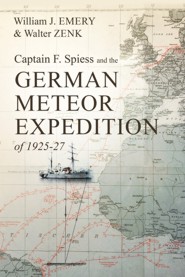
Captain F. Spiess and the German Meteor Expedition of 1925-27
by William J. Emery and Walter Zenk
Author website: https://www.colorado.edu/aerospace/william-emery
- Number of Pages: 298
- ISBN-10: 1627347127
- ISBN-13: 9781627347129
- Publisher: BrownWalker Press
- Year: 2019
- Category: History & Biography,
Synopsis
Banned from taking naval vessels to foreign ports after WW1 Germany undertakes a comprehensive oceanographic expedition to the Atlantic Ocean to test many new measurement systems and to establish the long term circulation patterns of the Atlantic. Challenged by the proscription on German naval vessels from visiting foreign ports after WW1 a group of German oceanographers from the Institute for Marine Sciences in Berlin carried out a pioneering research expedition from 1925-27 to sample the hydrographic structure of the South Atlantic Ocean. Its captain Fritz Spiess was the primary driving force behind the expedition and the German navy supplied the survey ship Meteor. During this 2.5 year expedition the Meteor scientists tested a great many new measurement systems many of which later became routine oceanographic measurement systems. As a result of their observations the mean circulation pattern of the Atlantic was revealed that has remained valid to this day.People interested in the history of ocean exploration, the history of Earth science and German scientific activity between the World Wars will find this volume to be an intriguing read. Much of the book has been taken from the original cruise report written by Captain Fritz Spiess (1933). In addition, his role has been expanded to demonstrate his essential contribution to the creation of the expedition, its execution and the dissemination of its results upon completion. The present text comments on the captain's life before and after the expedition.
In 1934 Fritz Spiess started his second carrier as President of the German Marine Observatory (Deutsche Seewarte) in Hamburg. A great number of so far unpublished documents demonstrate Spiess's ability to run his dignified agency in the turbulent times of Nazi Germany without becoming a Nazi himself.
Readers will learn how this first ocean expedition, dedicated to the study of the physics a whole ocean basin, helped to provide the background for modern physical oceanography.
REVIEWS
See post at GEOMAR - Helmholtz Centre for Ocean Research Kiel.
William J. Emery and Walter Zenk bring those times to life in their wonderful discussion of Captain F. Spiess and the German Atlantic Meteor Expedition of 1925-27 of the South Atlantic. As they say in the first sentence of 'Many of today's readers will be fascinated by the exciting story of the German oceanographic Meteor-Expedition from 1925 to 1927'. The effort of Captain Spiess and Prof. Albert Merz from the end of World War I to 1925 to make the Meteor Expedition a reality marks a remarkable feat of perseverance, so well documented by Emery and Zenk.
Professor Arnold Gordon of Columbia University's Lamont-Doherty Geological Observatory
What was the motivation for William Emery and Walter Zenk to provide a revised English translation of the report from the German Atlantic Expedition in 1925 to 1927 with the Navy vessel “Meteor” and complement it with their findings on Fritz Spiess, the ship’s captain, the later chief scientist and the author of the expedition report in 1928? There are two answers:
The first one refers to our present scientific challenge to predict climate change. Next to highly sophisticated dynamical modeling it needs repeated surveys on the status of our atmospheric, terrestrial and marine spheres. One of the earliest marine ones is the “Meteor 1925/27” data from a systematic coverage of a whole ocean basin. With its high level of measurement quality it has become a reference data set for all following analyses on ocean changes.
The second answer evolves when considering the nautical, the logistical and the scientific working conditions as extensively described by Captain Spiess during the two and a half years cruise: The crowding of crew and scientists in narrow living quarters and laboratories, the range-limiting storage capacity for coal and the difficult logistics related to Germany’s defeat in World War I. How could this merge with the extreme overall success of the Atlantic Expedition?
Some clue to this is offered in the chapter on the career and the personality of Fritz Spiess, which Emery and Zenk retrieved from a survey of relevant archives. The most clarifying statement found applicable to Spiess’ successful career characterized him as “Master of interacting with people”. This certainly helped to keep a positive attitude among crew and scientists towards the successful completion of their mission despite the numerous restrictions and thus it maintained the high quality of the observations throughout the Meteor-Expedition 1925/27.
Prof. em. Dr. Jens Meincke, Hamburg University, Experimental Oceanography
About the Author
W. J. Emery is a Physical Oceanographer and an Emeritus Professor of Aerospace Engineering at the University of Colorado.Walter Zenk is a retired Physical Oceanographer from the former Institut für Meereskunde at the Christian-Albrecht’s-Universität zu Kiel, today GEOMAR Helmholtz Centre for Ocean Research Kiel.






 View or Post a Review at Amazon.com
View or Post a Review at Amazon.com